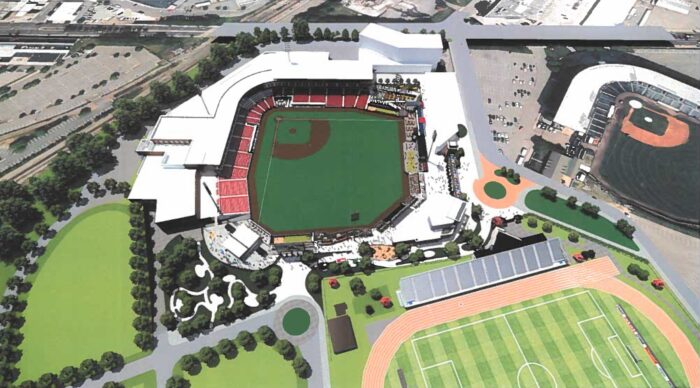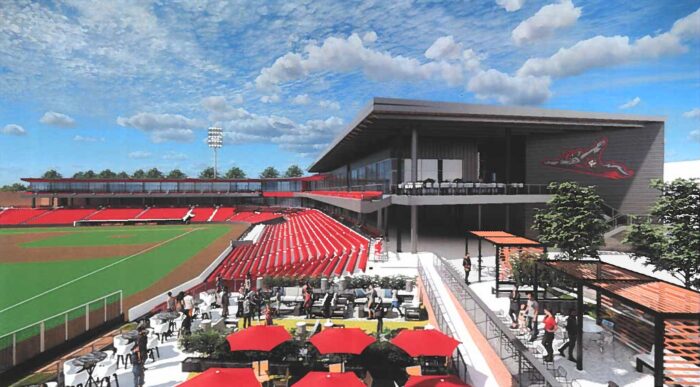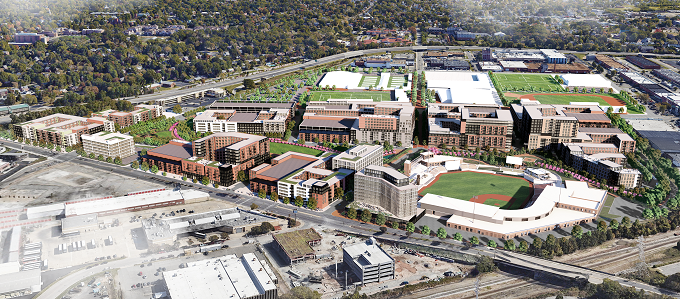
The new ballpark would rise just south of The Diamond, between Sports Backers Stadium and the railroad crossing along Arthur Ashe Boulevard. (City documents)
Four months after pitching in $1 million to keep the Diamond District ballpark project on track, Richmond’s Economic Development Authority is stepping back up to the plate with more funding for the stadium’s design.
In a special meeting Tuesday, the EDA board authorized staff to put another $1.5 million toward design and development of the new ballpark, via an amendment to its contract with the Richmond Flying Squirrels’ ownership group that provided the initial $1 million in December.
Leonard Sledge, the city’s economic development director, said those initial funds have technically been depleted and the additional money is needed to complete the design and development documents and value engineering for the $110 million stadium. The amendment would continue the contract through May.
“The EDA, because of the resources that it has available, is in position to keep the design moving forward on the ballpark,” Sledge said, describing the funds as critical to keeping the project on track so the stadium is completed by Opening Day 2026.
Sledge said the funds are available to the EDA due in part to a $1.2 million appropriation from the city. He said the $1.5 million would be reimbursed to the EDA through the bonds that the city plans to issue for the stadium and infrastructure improvements for the larger development’s first phase.
“The funding is there to do that,” Sledge said.
Navigators Baseball LP, the ballclub’s ownership group, has taken the lead on the stadium’s design and development, working with consultant Machete Group and architect Odell through an arrangement with the city’s Diamond District developer, now called Diamond District Partners.
That entity, led by Thalhimer Realty Partners and Loop Capital, remains responsible for the rest of the mixed-use development’s 30-acre first phase.
Since the initial $1 million was approved, schematic designs for the new stadium have been made public. And more recently, city administrators have announced a change in approach to how the ballpark and first phase of the larger mixed-use development would be financed.
The new approach for the first phase would involve the city issuing its own bonds, rather than having bonds issued through a community development authority. Doing so would allow the bonds to be secured sooner and keep them eligible for $24 million in state sales tax incentives through a program that’s set to expire in July.
While the city would assume the debt obligation on the bonds, issuing them based on the city’s established credit rating would lock in a lower interest rate, saving the city $215 million in debt costs over 30 years. Administrators say the move would not impact the city’s debt capacity and would free up nearly $24 million of debt capacity that had been programmed for city-funded infrastructure improvements.
In presenting the changes to the EDA board Tuesday, Deputy Chief Administrative Officer Sharon Ebert said, “The risk, we believe, is a much lower risk to move in this direction.”
Ebert said the $170 million in bonds the city would issue to finance the ballpark and first-phase infrastructure improvements would be paid in part by the Navigators’ lease, which she said would be $3 million annually for the first 10 years and then $1 million-plus with a 3 percent escalator cost every year thereafter.
“That lease payment is more than enough money to pay the debt service on the infrastructure bond,” Ebert said, referring to the $40 million bond for the first-phase improvements. The rest of the $130 million in bonds would go to the stadium.
The EDA’s contract with the Navigators has not been made public. Ordinances introduced by City Council to reflect the financing change and amend its agreement with Diamond District Partners refer to a separate development agreement between the EDA and Navigators for the ballpark, as well the ballclub’s lease agreement that needs to be signed before development can start.
Ebert said the development and lease agreements with the Navigators would be brought to the EDA board in coming weeks. She said those documents are in the process of being finalized.
She also said Machete Group and Odell are aiming to split up the design and construction work so that site work on the stadium can start in July and foundation work can be packaged later in the summer, with vertical construction on the stadium breaking ground this fall.
“That will guarantee us that the stadium will be complete for the 2026 baseball season,” Ebert said.
Chief Administrative Officer Lincoln Saunders, who accompanied Ebert at Tuesday’s meeting, thanked the EDA board following its approval.
“This is what the EDA is here to do, to enable us to move nimbly, move quickly, and then as we move forward with the larger bond sale, make sure that the EDA has those funds restored so we can be ready to be nimble and respond to the next opportunity we have as a city,” Saunders said.
“We appreciate the trust and collaboration, and we like what we’ve seen so far from the results of that funding with the stadium design.”
The additional funding for the ballpark comes as the city is budgeting $3 million to move forward with demolishing the Richmond Coliseum, which administrators consider a safety liability that’s costing $500,000 in annual security costs. Razing the structure is also recommended to help reenergize the stagnant City Center project that would redevelop the parcel and adjacent city-owned properties.
Correction: The EDA board’s action does not require approval from City Council. An earlier version of this story incorrectly reported that a council vote was pending.

The new ballpark would rise just south of The Diamond, between Sports Backers Stadium and the railroad crossing along Arthur Ashe Boulevard. (City documents)
Four months after pitching in $1 million to keep the Diamond District ballpark project on track, Richmond’s Economic Development Authority is stepping back up to the plate with more funding for the stadium’s design.
In a special meeting Tuesday, the EDA board authorized staff to put another $1.5 million toward design and development of the new ballpark, via an amendment to its contract with the Richmond Flying Squirrels’ ownership group that provided the initial $1 million in December.
Leonard Sledge, the city’s economic development director, said those initial funds have technically been depleted and the additional money is needed to complete the design and development documents and value engineering for the $110 million stadium. The amendment would continue the contract through May.
“The EDA, because of the resources that it has available, is in position to keep the design moving forward on the ballpark,” Sledge said, describing the funds as critical to keeping the project on track so the stadium is completed by Opening Day 2026.
Sledge said the funds are available to the EDA due in part to a $1.2 million appropriation from the city. He said the $1.5 million would be reimbursed to the EDA through the bonds that the city plans to issue for the stadium and infrastructure improvements for the larger development’s first phase.
“The funding is there to do that,” Sledge said.
Navigators Baseball LP, the ballclub’s ownership group, has taken the lead on the stadium’s design and development, working with consultant Machete Group and architect Odell through an arrangement with the city’s Diamond District developer, now called Diamond District Partners.
That entity, led by Thalhimer Realty Partners and Loop Capital, remains responsible for the rest of the mixed-use development’s 30-acre first phase.
Since the initial $1 million was approved, schematic designs for the new stadium have been made public. And more recently, city administrators have announced a change in approach to how the ballpark and first phase of the larger mixed-use development would be financed.
The new approach for the first phase would involve the city issuing its own bonds, rather than having bonds issued through a community development authority. Doing so would allow the bonds to be secured sooner and keep them eligible for $24 million in state sales tax incentives through a program that’s set to expire in July.
While the city would assume the debt obligation on the bonds, issuing them based on the city’s established credit rating would lock in a lower interest rate, saving the city $215 million in debt costs over 30 years. Administrators say the move would not impact the city’s debt capacity and would free up nearly $24 million of debt capacity that had been programmed for city-funded infrastructure improvements.
In presenting the changes to the EDA board Tuesday, Deputy Chief Administrative Officer Sharon Ebert said, “The risk, we believe, is a much lower risk to move in this direction.”
Ebert said the $170 million in bonds the city would issue to finance the ballpark and first-phase infrastructure improvements would be paid in part by the Navigators’ lease, which she said would be $3 million annually for the first 10 years and then $1 million-plus with a 3 percent escalator cost every year thereafter.
“That lease payment is more than enough money to pay the debt service on the infrastructure bond,” Ebert said, referring to the $40 million bond for the first-phase improvements. The rest of the $130 million in bonds would go to the stadium.
The EDA’s contract with the Navigators has not been made public. Ordinances introduced by City Council to reflect the financing change and amend its agreement with Diamond District Partners refer to a separate development agreement between the EDA and Navigators for the ballpark, as well the ballclub’s lease agreement that needs to be signed before development can start.
Ebert said the development and lease agreements with the Navigators would be brought to the EDA board in coming weeks. She said those documents are in the process of being finalized.
She also said Machete Group and Odell are aiming to split up the design and construction work so that site work on the stadium can start in July and foundation work can be packaged later in the summer, with vertical construction on the stadium breaking ground this fall.
“That will guarantee us that the stadium will be complete for the 2026 baseball season,” Ebert said.
Chief Administrative Officer Lincoln Saunders, who accompanied Ebert at Tuesday’s meeting, thanked the EDA board following its approval.
“This is what the EDA is here to do, to enable us to move nimbly, move quickly, and then as we move forward with the larger bond sale, make sure that the EDA has those funds restored so we can be ready to be nimble and respond to the next opportunity we have as a city,” Saunders said.
“We appreciate the trust and collaboration, and we like what we’ve seen so far from the results of that funding with the stadium design.”
The additional funding for the ballpark comes as the city is budgeting $3 million to move forward with demolishing the Richmond Coliseum, which administrators consider a safety liability that’s costing $500,000 in annual security costs. Razing the structure is also recommended to help reenergize the stagnant City Center project that would redevelop the parcel and adjacent city-owned properties.
Correction: The EDA board’s action does not require approval from City Council. An earlier version of this story incorrectly reported that a council vote was pending.







I fear something’s rotten in the Diamond District. I think by drawing inspiration from the dozens of aesthetically pleasing MLB-approved minor league parks around the country, I could come up with a basic design for a couple hundred bucks. Of course, I can’t draw a straight line with a ruler so don’t take my word for it.
Anytime “officials” from the City of Richmond are involved there is definitely something rotten going on.
If you read the article, the city is not designing the ball park.
“Navigators Baseball LP, the ballclub’s ownership group, has taken the lead on the stadium’s design and development, working with consultant Machete Group and architect Odell through an arrangement with the city’s Diamond District developer, now called Diamond District Partners.”
No, you’re correct….they’re only paying $1.2 Million here and another $1.5 Million there for the design of it.
Yeah. I’m sitting here looking at a new angle in this article of the overall “Diamond District” and seeing that an ugly, featureless 3rd base line of the exterior grandstand will greet visitors to this new premier destination as they travel across the bridge along the boulevard. Zero thought to curb appeal from the gateway. No surprise, this just continues the architecturally inept styling of the rest of the renderings.
Had an opportunity to do something great, and they’re going to massively fumble the ball (or, rather shall we say, balk?)
Amazing!
Wonder how many more of these creeping fleecing of the taxpayer stories we will see. A million here, a million there, pretty soon we are talking real money.
Given the city’s history with value engineering I except no less than a 25% increase construction costs once the contract is signed.
The amount of fraud, waste and abuse usually written off an accounting rounding error in these types of projects is sickening. A project with Millions of overages already in the “design” phase will surely end up fleecing us all as Taxpayers.
Unfortunately, this has been an exhaustingly long project that has already eclipsed deadlines. The dream was only an enticingly presented nonsensical illusion. The mayor’s administration has a long record of soundbites that funnel down to zero follow through. If this ballpark were to be made, they would have had a design plan in hand within 90 days of the winning bidder being announced. And the construction would be almost finished. Goodbye Flying Squirrels. We loved you while you were here.
Hears my proposal,
#1 build a Statium that’s meets MLB standards
#2 demolition of existing Diamond
Done deal,play ball!
If every non-major league city got together and agreed to tell the MLB, “you get what you’ve got” – guess who doesn’t get to mandate standards anymore and fleece the taxpayers?
The City is all in, would you say? The renderings are one heck of a lot more appealing than The Jumbo Shrimp Park in Jacksonville, a Triple A facility. I haven’t been to others to compare. The seats are very close to the field and the amenities are appealing. I disagree with the other amateur architects who’ve commented on this page. I think it’ll be a darn nice venue and center piece for Thalhimer to build around. If the Squirrels cannot make it here as a Double A team, perhaps we can draw The Nationals Triple A program.
I know I sound like an old geezer but it would be great to bring baseball back to Richmond with a Triple A team. I appreciate that the Squirrels may be an asset but I’m not a fan of baseball-tainment. Are they still Playing the game Guess Which Bar Parney Passes Out in Tonight? I guess even MLB is probable more fun and (non-baseball) games these days. And I admit the R-Braves had turned the diamond into a mortuary in their last days. But I would love to watch real baseball here again. Just to confirm that I’m too out… Read more »
AAA Ball does the same things AA ball does these days, so that wouldn’t change anything.
Parney has been instrumental in establishing the Squirrels as a presence in Richmond, and has been a phenomenal ambassador for the organization. He’s fearless and will do anything – ANYTHING – to create an entertaining environment for the fans.
Why the hate and slander for the **former** point person for the Squirrels?
How is there still not a design in place? This should be almost built by now.